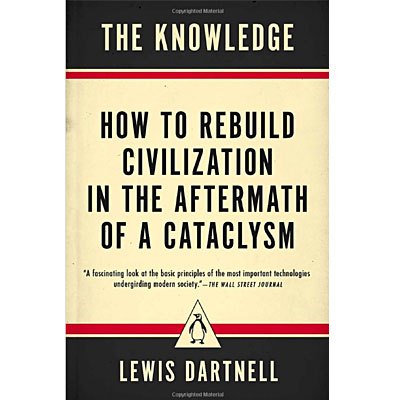
How to Create Writing, Paper, and the Printing Press From Scratch
In uncertain times, it's sometimes a comforting exercise to reflect back upon the traditional methods of life, when communities were on there own to supply their basic needs from the materials around them.
In that prepping spirit this article is going to look at the basics of written language and knowledge sharing and how to create the tools and implements to support them: paper, pen and the press.
In our modern civilization we take many things for granted. Such as wireless networks, mobile phones, the Internet and, with them, all other types of instant communication.
How would replace these technologies if they were to suddenly disappear?
Making Paper From Raw Nature
The Chinese were the first to invent paper, a technology that predates Europe by about a thousand years. But the Chinese used a different type that we are used to.
Modern paper, the white smooth sheets of a notebook, for example, is actually a fairly recent invention which can be traced back to the late nineteenth-century.
Before that point, most paper was made out of linen fragments. Linen itself being a type of fiber that comes from flax plants.
In theory, any plant that is fibrous in nature can be turned into paper. That includes grass, nettles, and hemp.
Modern paper is uniquely very light and relatively tough. To make it, we would need to harvest plant fibers that are mainly cellulose in nature.
The problem is, cellulose is hard to extract from plants, because the cellulose itself is often intertwined with other plant chemicals. Separating the cellulose from other chemicals requires a process known as ‘retting’.
To do this, plant stems need to be crushed and left soaking in still water for weeks on end.
After a while, microbes will break down and soften the stalks, which then must be effectively beaten — like punch bags — to remove the cellulose from them.
Modern paper is made from cellulose that belongs to the trunks of trees. This cellulose is tightly locked in with a strong chemical called lignin.
Fortunately there is a way to separate both the cellulose and the lignin by utilizing a chemical process known as hydrolysis.
The Process of Remaking Modern Paper
Hydrolysis is a common molecular operation that is used throughout the industrial world, and paper-making is no exception.
To even begin to make modern paper you will need to get a tree trunk and chop it up into small pieces.
The next thing to do is to place the tiny bits of wood into a vat of boiling alkaline solution for a few hours. It is the corrosive alkali that will work to undo the cellulose-lignin bond in the wood.
There are many ways to make an alkaline solution, but most of them require some degree of knowledge about chemistry, and a modest laboratory setting. There is an ‘easy’ way to make the solution for the hydrolysis process however, and this is through urine fermenting.

Human urine contains ‘urea’ in it, a type of nitrate that — if left to the whims of microbiology — quickly turns to ammonia. If you’ve ever visited a smelly public bathroom, you know what ammonia smells like.
This incredibly low-tech solution will soon begin to break down the chemical bonds of the wood. And while the ammonia will destroy both cellulose and lignin in time, it importantly will destroy the lignin first — giving you a clear window to separate and remove the cellulose fibers.
Once the ammonia-solution has done its job, it will begin to turn into a broth that resembles dirty bath water. The cellulose will float to the top in the form of short, white fibers for you to collect. Give the fibers a rinse and spread them over a wire mesh or a framed cloth screen.
The fibers should look and feel sloppy, and almost like porridge at this point. Pour the sloppy cellulose over the mesh and squeeze it as you go, forcing any remaining water out, and then let it dry.
The finished product should resemble something like the smooth sheets of paper we take for granted today.
Making Ink from Raw Nature

The ink derived from plant galls is still used widely across Europe and America to this day.
Your newly crafted paper won’t be much use without ink.
Anything that leaves a stain can be called an ‘ink’. For example, it would be pretty easy to mash up some berries, preserve them with salt, and use the berry-juice as an ink.
The problem is durability. A good ink doesn’t just wash off or vanish. It stays around, committed to the paper.
This is crucially important, because if information is to be retained, it needs some form of permanence.
The Europeans of the middle-ages were the first to discover just such an ink, which is still used in courtrooms today.
‘Iron gall ink’ as it is known, cannot easily be scrubbed off or smudged, and is sunlight-resistant. This type of ink is made by ‘galls’ — little tiny, wart-like instances on plants and leaves that form whenever a parasitic wasp irritates the plant.
They are heavy with tannic and gallic acids and when mixed with an iron compound, the acids form into a deep, enduring black ink.
Reinventing The Pen

You can make a quill pen from straws, as well as feathers Img src and directions
Mercifully, the pen is the easiest thing to make from scratch — sort of.
Anyone who has seen a film set in medieval society will know what a rudimentary pen looks like. The best feathered-pens (quills) are made out of duck or swan feathers.
All you need to do is clear away any material from the shaft of the feather, and sculpt or sharpen the end of the quill into the classic shape of a writing nib.
Another pro tip: sharpen a slight slit into the nib. This will allow a tiny reservoir of ink to perch on the end of it, reducing the amount of times it will need stocking up on iron gall ink from your inkwell.
Building a Printing Press

Unquestionably, the printing press is one of the most important inventions of all time.
Originating in Germany in the 1400s, the progenitor printing press consisted of a row of cube-shaped blocks in a rectangular frame. Each of the blocks had a different letter imprinted on it.
The way it worked is simple: the cubes would be dipped in ink and then pressed on to the paper. It is still labour intensive, as all of the blocks need to be reorganized into the order of the next written page of text, but as inefficient as it sounds, the printing press will still be hundreds of times more efficient than writing everything down by hand.
To make a printing press two things are required. The tech to efficiently ‘press’ ink on to paper, and a means to make typecast molds of an identical lettering.
The best way to make the typecasts is to make them with both straight smooth sides and right-angled edges. Designed like this, they should easily be able to slot alongside other typecasts and made into rows of blocks.
The letter shapes can be crafted on the end face of the blocks via a swappable matrix at the base of the mould.
Matrixes like this can be fashioned out of malleable metals such as copper. You can then hammer in the indents of each letter or number with a single steel punch.
Using this method, there’s only the need to make one engraving of each letter, number, and symbol on each punch which should make it much easier to publish content rapidly and of identical type.
In order to put the ‘press’ back into your printing press, you will need a forceful mechanical device but if all of the current printing press technology is not viable, then a simple lever or pulley system should do the trick.
Printing Press Ink
The unfortunate reality here is the iron gall ink you made for your pens and paper won’t be of any help on a printing press. A new type of ink — viscous ink — will have to be reinvented.
The beauty of this ink is that it is really resistant to blurring and smearing, and this is exactly why it is the ink of choice for printing presses. It does not smudge after it is pressed on to the paper.
Viscous ink is made out of soot, the tiny particles of which act as a dark pigment. When mixed with water and a thickener such as walnut oil (or even better, turpentine if you have access to it), the three ingredients should dry and stick well when used on your press.
You can adjust the ratio of the ingredients as you go too, to manipulate the quality and stickiness of the ink.
Now it's Your Turn
Be the shoulders that future generations stand on.
The great Isaac Newton once famously remarked that “If I have seen further it is by standing on the shoulders of giants”.
What he meant by that was, if it were not for the collective wisdom stored away from past experiences in libraries of books, he would never have been able to add to that wisdom in the form of his theory of gravity and with his contribution to physics in general.
Civilizations can only advance if they preserve the written language and by extension accumulate the knowledge that comes with it.
Only by taking the trouble to reinvent writing, ink, and the printing press, is there hope for a recovery of lost civilization.
If you want to learn some other concepts about recreating modern technology in a post-modern world, check out this book by Lewis Dartnell:
The Knowledge: How to Rebuild Civilization in the Aftermath of a Cataclysm
Typical Price: $15
If our technological society collapsed tomorrow what would be the one book you would want to press into the hands of the post-apocalyptic survivors? What crucial knowledge would they need to survive in the immediate aftermath and to rebuild civilization as quickly as possible?
Human knowledge is collective, distributed across the population. It has built on itself for centuries, becoming vast and increasingly specialized. Most of us are ignorant about the fundamental principles of the civilization that supports us, happily utilizing the latest—or even the most basic—technology without having the slightest idea of why it works or how it came to be.
If you had to go back to absolute basics, like some sort of post-cataclysmic Robinson Crusoe, would you know how to re-create an internal combustion engine, put together a microscope, get metals out of rock, or even how to produce food for yourself?
About the Author
This article was written by Neil Wright of McGowan Transcriptions.
















